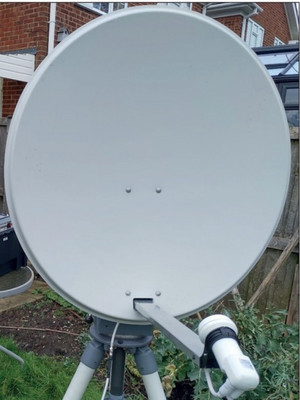Sie wurde mit einem LNB mit einem Ausgang geliefert, den ich beiseite legte und durch einen rauscharmen PLL-Typ von Octagon ersetzte. Ich richtete sie dann auf Es-hail-2 aus und empfing die Breitbandbake von QO-100. Der Empfang war für eine Schüssel dieser Größe recht ordentlich mit einem MER von bis zu 8,5 dB.
Da die Downlink-Frequenz der Breitbandbake bei etwa 10,5 GHz kommt, liegt die Frequenz des ZF-Signals, das auf dem HF-Ausgangskoax erscheint, bei etwa 750 MHz, wenn der LNB-LO 9750 MHz verwendet wird. Um dieses Signal zusammen mit den DATV-Übertragungen mit niedrigerer Symbolrate zu empfangen, verwende ich einen Minitiouner mit einem Ryde-Empfänger oder ein Portsdown-System. Was mir an dieser Schüssel gefiel, war die Tatsache, dass der Speisearm mitsamt dem angebrachten LNB leicht abgenommen werden konnte, was die Unterbringung in meinem Auto erleichterte.
Jen Easdown, G4HIZ
Quelle: CQ-TV 288
Jährliche DATV-QSO-Party
Die DATV QSO-Party wird wieder am Samstag, den 30. August um ca. 0000 UTC stattfinden (Freitagabend in USA). Wir beginnen wie immer mit Art Towslee in Columbus und seiner Zoom-Gruppe. Rowland Hoffman, KC6JPG, wird ebenfalls seine Netzwerke in Los Angeles präsentieren.
Peter Cossuins, VK3BFG
Quelle: ATV-Journal 191
NOAA-Wettersat-Ende
Wie die US-Regierung zuvor angekündigt hatte, werden derzeit die verbleibenden Satelliten der alten POES-Konstellation (Polar Operational Environmental Studies) der National Oceanic and Atmospheric Administration außer Betrieb genommen. Der POES-Satellit NOAA-15 sollte am 12. August und ein weiterer, NOAA-19, am 19. August außer Betrieb genommen werden. Anfang dieses Jahres wurden beide zusammen mit einem dritten Satelliten der Konstellation, NOAA-18, der im Juni außer Betrieb genommen wurde, für ausgelaufen erklärt. Jahrelang waren diese Satelliten für viele eine wichtige Quelle für Wetterdaten über ihre analogen 137-MHz-APT-Übertragungen und lieferten Bild-Daten, die zur Überwachung der Umwelt, von Waldbränden, Vulkanausbrüchen und der globalen Vegetation verwendet wurden. Obwohl frühere Berichte besagten, dass die Übertragungen der Satelliten fortgesetzt würden, heißt es in einem Artikel auf der RTL-SDR-Website, dass die Sender abgeschaltet werden sollen. Der Status „Ende der Lebensdauer” bedeutet, dass sie nicht mehr repariert oder wiederhergestellt werden können, und die NOAA rät davon ab, sie als zuverlässige Informationsquellen für kritische oder Notfallzwecke zu betrachten.
Jen DeSalvo, W9TJX
Quelle: AR-Newsline
ARISS radio contact between OR4ISS and FX5YOTA on August 19, 2025.
Astronaut Mike Fincke, amateur radio call sign KE5AIT, will operate the amateur radio equipment aboard the International Space Station. Mike will answer questions from students in France during this live amateur radio contact.
This amateur radio contact is scheduled for Tuesday, August 19, 2025 at 09:18 UTC. Astronaut Mike Fincke will operate the amateur radio station call sign OR4ISS aboard the ISS and will call the radio amateur ground station call sign FX5YOTA in France. This is a live ARISS radio contact from the Youngsters On The Air - Summer Camp in Jambville, France.
You can listen live to astronaut Mike Fincke aboard the ISS on 145.800 MHz FM (plus/minus 3 kHz Doppler shift).
The event will be streamed live:
https://www.youtube.com/watch?v=MARkTcR6Njo
English is the expected language of communication in this amateur radio contact.
Questions (as time allows):
1. What types of emergencies do you train for on ISS?
2. What's the biggest question/curiosity you had about life before becoming an astronaut?
3. What was the most unexpected thing that happened to you in space?
4. What is the funniest thing to do in space?
5. How are crew and equipment on the ISS protected from solar radiation?
6. What were your first thoughts after seeing the Earth from above?
7. Can you describe how the ISS sounds like inside?
8. How does your body feel when you come back to Earth after being in space?
9. Was there an experiment where you had to improvise something?
10. How often do you get on the radio to make QSOs with HAMs?
11. Is amateur radio important for the ISS?
12. Back on Earth, how often are you active on the air and what's your favorite band/mode?
13. How do you cope with being away from family for a long period of time?
14. What's the first thing you would do back on Earth?
15. Can you describe your first ham radio contact from the ISS?
16. Will humanity be able to live on another planet/moon in the upcoming decades?
17. In your opinion, what skills are essential in becoming an astronaut?
18. Have you operated in Morse code as part of your amateur radio or other communication activities?
19. Does the time passed in space feel any longer or shorter than on Earth?
20. Is oxygen depletion highly affected by the growth of plants/micro-organisms on board?
The ARISS program is aimed at students and enthusiasts and aims to inspire them in the study of sciences with this amateur radio activity. The demonstration of amateur radio communication from space invites schools and universities to make use of these educational technical resources. We invite radio amateurs and space enthusiasts to tune in to this exciting moment.
Check out the ARISS website and follow ARISS on the official social media channels for more updates.
https://www.ariss.org/contact-the-iss.html
Quelle: ARISS-Europe News Bulletin, Jan ON7UX.

